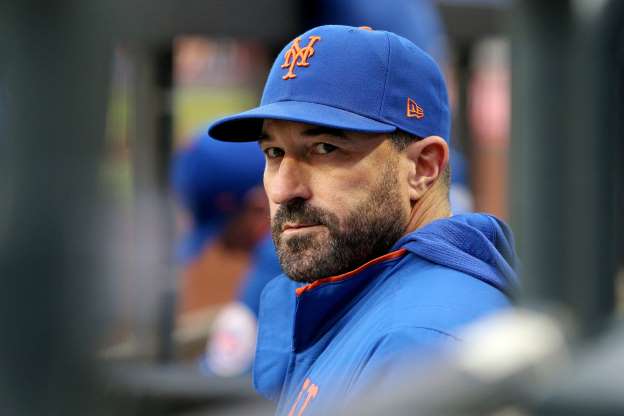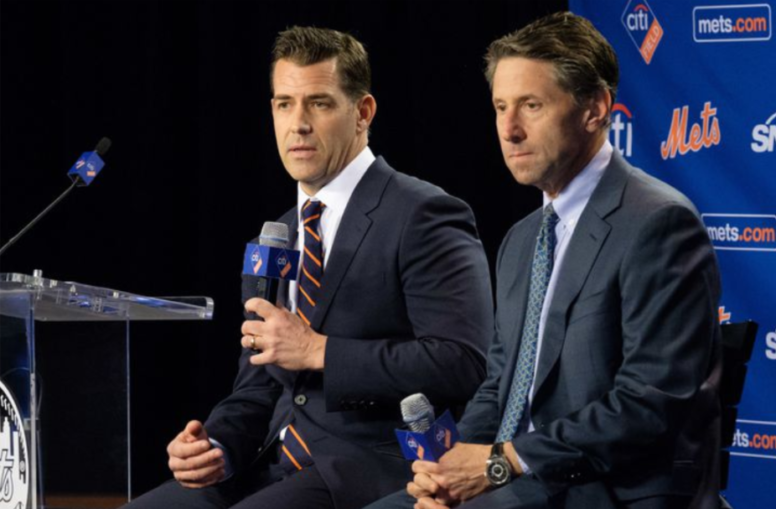
On Sunday, Mickey Callaway had a bad day in the dugout, and then the day got even worse when he engaged in a (mostly one-sided) shouting match with Newsday beat writer Tim Healey.
Though the Mets’ front office has maintained the utmost confidence in him, it’s not particularly difficult to grasp that Callaway’s days with the organization are all but numbered at this point. Cursing out a reporter and precipitating a clubhouse altercation is not how winners are built. Failing to properly apologize the following day, but even more inexplicably letting a 13-year veteran pitcher in Jason Vargas completely refuse to either apologize or take further questions, is the stuff of a 1993 fever dream.
It takes much more effort, however, to unpack just how brutally and, in some respects, unfortunately, Callaway has fallen in terms of credibility. Lost among the shuffle of questionable lineups, frustrating late-game decisions, and media gaffes that have ranged from laughable to flagrant is a once-lauded hiring who has shouldered the brunt of day-to-day criticism across over a year of far deeper ineptitude.
Today’s Mets skipper has justifiably been laughed at for his inability to communicate with players, namely Robinson Cano as well as pitchers Noah Syndergaard, Jeurys Familia, and most-recently Seth Lugo. But for the better part of the 2019 season, some of his most outrageous responses and sound-bites have involved analytical approaches and personnel decisions.
From his perplexing infatuation with non-existent head-to-head stats all the way back to his decision last year to bench a young, red-hot Amed Rosario and supposedly protect him from Nationals ace Max Scherzer, baseball fans have borne witness to the spectacle of a once-revered, forward-thinking Cleveland Indians pitching coach explaining (used loosely) his way into obscurity.
Just as the case was in May last season, when the Mets’ 11-1 start soured and shriveled up before festering into an embarrassing summer of sub-.500 baseball, cracks began to show, even with a roster that now boasted one of the game’s best closers in Edwin Diaz and a first baseman who already has 27 homers and 61 RBI in Pete Alonso. This team somehow hasn’t spent a day over the .500 mark since May 2.
Even last year’s squad waited till the first day of June to go under. Talks of Callaway’s imminent firing have swirled for nearly two months now. So what gives?
To find the answer, one must attack the more appropriate question: “what gave?”
When Callaway addressed the media for the first time in February 2018, one of his first, perhaps most groundbreaking statements was that he would likely not appoint a definite closer, instead opting to go by committee and picking out the best arm when the situation called for it:
“We have to make sure we get to a save situation,” he said. “And if we can’t get there, it doesn’t do any good to have this guy being named the closer.”
Now let’s fast-forward to Sunday’s loss, where he pretty much admitted that he had no intentions of throwing Díaz against slugger Javier Baez, citing that, with one out in the eighth, he intended to push Seth Lugo (who was clearly winded) through two innings.
This isn’t the first time Callaway declined his best weapon in a dire spot. Of his decision not to use Díaz in the eighth inning in a game against the Philadelphia Phillies that would end in an extra-innings win, he was equally obtuse, saying, “He’s not going to get four outs. He’s going to get three.”
The bullpen bugaboo is just one of several instances in which Callaway’s in-game philosophy has seemingly gone for a 180. When Callaway made his managerial debut in spring training, Tyler Kepner of the New York Times delivered a promising outlook, drawing from testimonials from Cleveland’s own vaunted pitching staff of Corey Kluber, Trevor Bauer, and Mike Clevinger, among others. Perhaps the most intriguing and, in retrospect, disheartening attributes of Callaway’s was his scientific approach to his pitchers – regarding both health and effectiveness.
One can only wonder where the numbers go when the same pitching guru, asked about how he decides which catcher to start, cites the team’s win-loss record when Wilson Ramos plays. Even Callaway himself seemed unsure:
“I mean, yeah, we want to win, right? You win a lot. That’s how I look at it, absolutely.”
On one hand, the blatant flip-flopping should be the clearest indication that Mickey Callaway isn’t cut out to manage a big-league baseball team in New York; the expletive-laced fiasco in the wake of Sunday’s loss should be his ticket out. But it won’t be, however sensible it is, and the New York Post‘s Mike Puma essentially confirmed it in a phone call with WFAN that night.
Callaway’s hostile reaction to a benign “see you tomorrow” from Healey was described by Puma as “a cry for help.” Puma also posited that “he’s getting coached [on what to say, setting the lineup, using relievers, etc.]” and yesterday expressed a belief that the front office “doesn’t think [bench coach] Jim Riggleman is as controllable as Mickey.”

Another article from Puma details general manager Brodie Van Wagenen’s phoning into the Mets’ dugout, a potential violation of league policy, but an even damning encroachment on the manager’s in-game autonomy. Van Wagenen reportedly ordered him to pull a cramping Jacob deGrom, and has reportedly had a say (along with other unnamed higher-ups) in the team’s plan to restrict Díaz to the ninth inning. Among a handful of dubious decisions, especially from someone of Callaway’s background, there are clearly other strings being pulled.
Puma’s closing point on WFAN, if his prior work hasn’t already, underlined in fine print what it is exactly that has brought Mickey Callaway to such a juncture in his tenure with a Mets team that appears (to put it nicely) to be going under:
“He’s a puppet.”
To many, this isn’t a novel concept, and if anything, it’s been apparent for over a year. Cracks began to show beyond the team’s inability to simply win games – from the mishandling of Yoenis Cespedes‘ hamstring injury (again) to the team’s baffling decision to refuse Dominic Smith playing time at first base. The lineup card couldn’t possibly have been in this same manager’s hands.
Arguably the most confusing, recurring development through Callaway’s first full season in 2018 was the consistency with which Jose Reyes received playing time over not only a far more important Rosario, but also younger, more promising options as Jeff McNeil and Luis Guillorme.
Reyes, who was coming off his worst defensive season by far (-2.1 dWAR) and had already been running on borrowed time after his domestic violence arrest left him jobless in 2016, had started just three times in the team’s first 25 games. Shortly after Reyes took to the papers to complain about his lack of playing time in June, he wound up starting in over half the games he appeared in, often supplanting Rosario himself as the Mets evidently prioritized saving face over developing a winning core.
Be it by coincidence, lack of accountability, or swift punishment from upstairs, Callaway was the only person who ever fielded and answered questions about the veteran from that point on. The same thereby applied to the case of McNeil through the next month as the front office further resisted promoting him. Nearly a year later, Callaway’s description of McNeil a “strictly a second baseman” remains a running gag among fans waiting for someone else to fill the chair.
A similar narrative is presently unfolding with right-hander Jeurys Familia, who despite holding an ERA north of seven, has faced nearly a third (32.8%) of his batters in high-leverage situations. It’s convenient to blame Callaway for making the decisions sight-on-scene, but let’s remember that this same manager seemingly had no idea that Familia had been placed on the injured list the moment it was announced.
Between the team’s present futility and the unsolicited clubhouse fight, the circus has gone from tired to unbearable rather abruptly. But make no mistake: this form of meat-shielding has been more prevalent with Callaway – someone who has never managed, much less worked in New York – than most would admit. Callaway’s postgame responses, as befuddling as they are, only offer a more transparent look into what has held this team back through the years.
When Callaway is inevitably let go, whenever that day may be, he won’t leave the way Mike Matheny left St. Louis, nor when Don Mattingly left the Dodgers. The Mets will not magically transform into a winner, whether they appoint Riggleman, Luis Rojas, Phil Regan, Terry Collins, David Wright, or even Wally Backman (because fans are still talking about this).
Say what you must about Mickey being the team’s worst manager since Art Howe (a reactionary and unfair stance in itself), there likely won’t be a rainbow at the end of this storm. The organization took a smart, respected pitching coach, brought him to a team that needed its pitching revived after 2017, got off to one of its most exciting starts ever, and immediately exploited his inexperience.
The lack of communication, continued mismanagement of injuries, and frequent, somewhat arrogant inability to make adjustments has dampened 2019 just as it has all the way back to those final seasons at Shea Stadium. It’s one of the few areas in which this franchise has been consistent, and it should come as no surprise to any fan of this team when Callaway, wherever he lands next, enjoys success again – be it as a pitching coach or manager. Feeding Callaway to the wolves, whatever it “shakes up,” is a short-term benefit against a current of incompetence.














